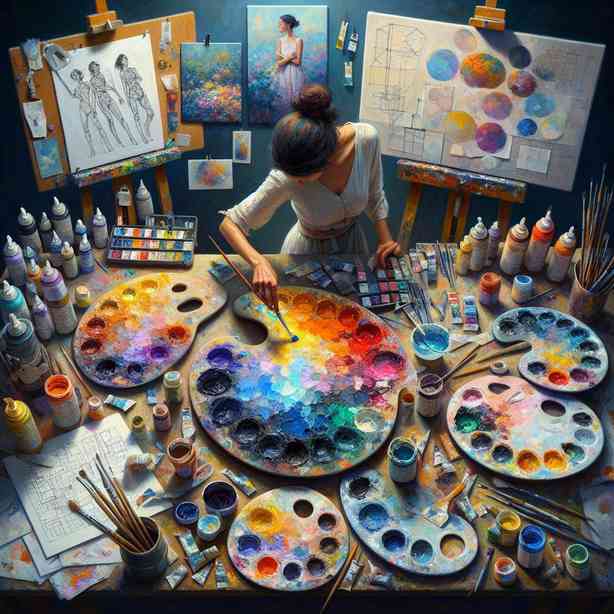
Taking photos of your palettes is a practice that has gained popularity among artists, designers, and creative enthusiasts alike. This act not only serves as a means to document one’s creative journey but also offers numerous benefits that can enhance one’s artistic process. In this discussion, we will explore various reasons why capturing the essence of your palettes can prove to be a valuable tool in your creative toolkit.
Firstly, photographing your palettes provides a visual record of your color choices and compositions. Over time, you might find that your artistic style evolves, and different color schemes appeal to you at various stages of your creative journey. By taking photos of your palettes, you create a visual diary that chronicles these transitions. It’s fascinating to reflect on how your color preferences have changed, and this record can be a source of inspiration when working on future projects. You can easily look back at your photos to see what combinations sparked joy or led to successful pieces.
In addition, documenting your palettes can be beneficial for maintaining consistency in your work. If you’re creating a series of pieces or working on a particular theme, having photos of your palettes can help you remember the specific colors and styles you employed. This consistency is crucial in establishing a cohesive body of work. It can be a bit challenging to recreate a particular shade or combination from memory alone, especially if it was a unique blend. Therefore, having a photographic record ensures that you can replicate those captivating combinations with ease.
Moreover, sharing photos of your palettes on social media or with fellow artists can foster community and collaboration. The art world thrives on inspiration and dialogue, and showcasing your work can serve as a springboard for discussions about techniques, preferences, and artistic intentions. Social media platforms such as Instagram or Pinterest are fantastic venues for sharing images of your palettes, and they can help you connect with like-minded individuals who share your passion for color and creativity. Engaging with a community of artists can lead to new ideas, collaborative projects, and even friendships.
Another important aspect of photographing your palettes is the opportunity for self-reflection. When you take a moment to observe and capture your color choices, you engage in a process of self-discovery. Understanding why you are drawn to certain colors or combinations can enhance your artistic voice. Are the palettes you gravitate towards a reflection of your current feelings or experiences? This introspection can be beneficial in developing your artistic identity and can provide clarity in your creative goals.
Additionally, capturing your palettes can also serve as a source of motivation. Every artist goes through periods of creative block, and revisiting past palettes can reignite inspiration. You may find that certain combinations remind you of a successful piece or evoke a feeling that pushes you to create once more. In times when your creativity feels stifled, looking at the colors you once loved can remind you of the passion that drives your art and encourage you to experiment with new ideas.
Furthermore, taking photos of your palettes can enhance your organizational skills. In the fast-paced world of art and design, keeping track of your materials, ideas, and inspirations is essential. By organizing your palette photos, you can create an easy reference system. For digital artists, creating folders or mood boards that include palette images can streamline your workflow and ensure you have quick access to colors that resonate with your current projects.
Incidentally, this practice may also help you in learning about color theory. When you photograph and analyze your palettes over time, you can notice patterns in your color choices and gain insights into color relationships. This knowledge can deepen your understanding of how colors interact, enabling you to make more informed decisions in your future works. As you reflect on what combinations worked well and which didn’t, you’ll become more adept at manipulating color, making your artwork even more engaging.
Lastly, photographing your palettes can serve as a form of artistic expression in itself. The arrangement of colors and materials can create visually appealing compositions. By experimenting with different layouts and backgrounds, you can create a series of artistic photographs that represent your unique style. These images can be considered a part of your portfolio, displaying not just your finished works but also the very foundations of your artistic process.
In conclusion, there are numerous reasons for taking photos of your palettes that extend beyond mere documentation. This practice not only helps to preserve your creative journey but also enhances your artistry through consistency, community engagement, self-reflection, motivation, and organization. It invites a deeper understanding of color theory and allows for personal expression. Embracing this habit can transform your approach to art and design, igniting new ideas and connections with others in the creative world. So, the next time you assemble your colors, consider capturing that moment with a photograph; it might just become one of the most valuable resources in your artistic journey.


